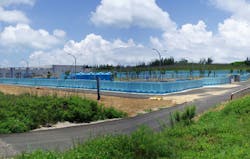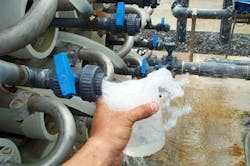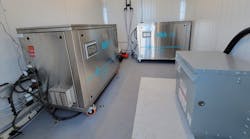Taiwan is earmarking a multi-billion dollar budget to start reclaiming wastewater on a large scale, set to provide 10% of its supply by 2030. WWi visited the Aqua Taiwan show to find out more about the country’s growing water industry.
By Tom Freyberg
The small island nation of Taiwan, 180km east of China, may be known more for its electronics manufacturing than progressive water industry but that could soon change.
In the middle of December, the country’s Ministry of Economic Affairs (MOEA) heralded what it called a “new era for the use of reclaimed water”. Passing the “Reclaimed Water Resources Development Act”, the Ministry estimates that by 2031, 10% of Taiwan’s public water supply will come from reclaimed sources.
Facing its worst drought in nearly 70 years last year, reclaimed water as an additional water source could not come quick enough.
“More and more scientific evidence shows that climate change is resulting in extreme weather…what we have observed in Taiwan: extremely dry days and heavily rainy days are both increasing,” the MOEA says. “These are all unfavourable for water resource development.”
Quenching Taiwan’s thirsty manufacturing industry
To progress to this new era, Taiwan is approaching wastewater reuse from a different angle to the well-publicised NEWater story in Singapore.
Despite historically receiving some of the highest rainfall levels globally, the island has failed to harness this water for potable and industrial purposes. As a result, many manufacturers have urged the Taiwanese government to do more. The industry wants a solid, future proof water supply.
To feed its thirsty network of manufacturing plants, Taiwan plans to clean up municipal wastewater. A total of NT$15.2 billion (US$465.8 million) will be invested to develop six wastewater reuse plants at Fongshanxi, Futian, Yongkang, Linhai, Anping and Fengyuan from 2016 to 2021, piping reclaimed water to industrial sources.
Two tenders will kick-start the process. First up will be port city Kaohsiung with a 70,000 m3/day plant. A second will follow in Yongkang, Tainan.
Speaking to WWi magazine, Jennifer Chen, deputy director general from the Kaoshiung City Government says that Taiwan needs to globalise and that she’s encouraging international companies to join forces with local companies to bid.
Economics
For wastewater reuse to work for municipal supplies, it needs to be accepted by the customer i.e the public. For it to work for industry, the economics need to be right.
According to Taiwan Water Corporation (TWC), water tariffs have been frozen on the island for two decades. As a result, water has been too cheap on the island for too long. There has been no incentive for industrial users to even consider reclaimed wastewater as an alternative, until now.
Hsiao-Hhua Chen, VP of Taiwan’s EDF (Environment and Development Foundation) says that the problem has been to find willing end users for reclaimed water. The low price has been the limiting factor. It they can find cheaper resources, then of course, the cheapest price wins.
A desperate need for ultrapure water for the country’s semi-conductor industry, coupled with the “master plan” to use reclaimed water should hopefully by-pass the issue of cost, given the sheer demand.
Sub-surface desalination intake
On the desalination front, currently there are three small scale plants operating in Taiwan, all on the island of Penghu. Although a tender was issued for a fourth by the Taiwan Water Corporation, it received only one bid, from engineering firm Kuo Toong International, who operates two of the existing plants.
Speaking to WWi, manager Phil Hsieh says that due to protests from local fishermen on the potential impact of an open intake, the tender mandates that a sub-surface intake is used instead. As we have witnessed in California, where a similar mandate is underway - potentially adding hundreds of millions of dollars to new desalination projects - this is causing controversy. Local bidders apparently won’t go near this fourth tender. They believe an extraordinarily hard rock on the island will be difficult to drill for the intake. Kuo Toong International says it will be employing a contractor who has experience in this area. It this project reaches fruition, it would come online by the end of 2017.
Interestingly, a large scale desalination plant could also be used on mainland Taiwan by the end by 2020. Hsieh said that a 300,000 m3/day project is expected to go to tender but not until 2019.
A third of produced water will be used for household water, with the remaining two thirds for industrial purposes. The latter would be used by the Southern Taiwan Science Park and Taiwanese semiconductor company, TSMC.
Getting smart on NRW
Non-revenue water (NRW) is another challenge for the island. In 2013, the Taiwan Water Corporation reported a 27% NRW rate. This worked out to be a NT$2.5 million per day financial loss (US$76,000).
In the same year, water leakage was reported to be 18.9%. To reduce these figures, the “Water Leakage Reduction Plan (2013-2022) sets out to reduce water leakage to under 15% by 2021.
Part of the problem is that it’s very common in South East Asia for people to try and cheat meter readings. Eric Lin from Taiwanese metering company, EMS, says that they either use magnets to stop the meters, by-pass with pipes or reverse them in order to give false readings. Advanced Meter Reading (AMR) technology has picked up pace in Asia and developed to counter such tampering. Taiwan is trying to share its knowledge on this area outside the island: EMS recently signed a new contract in the Philippines to supply 1000 homes with its smart meters.
Innovation drive
At the end of September, reports showed that super typhoon Dujuan killed two people and left more than 300 injured in Taiwan after sweeping across the North of the island on its way to China.
Typhoons are a real threat in Taiwan and the destruction left can leave thousands without electricity and water. The need for scaled down water solutions in emergency situations is driving innovation
The country’s Industrial Technology Research Institute (ITRI) has developed a four-stage, mobile water treatment unit it calls QWater. Using biocarriers, activated carbon, membranes and finally UV technology, the unit can provide 15 m3/day of drinkable water for 5000 people.
Already deployed to the Philippines and used in Taiwan for typhoon relief, the scaled down system is impressive and demonstrates the adage that necessity is the mother of invention.
Tom Freyberg is chief editor of WWI magazine, for more information on the article or Taiwan’s plans for wastewater reuse email: [email protected].
More Water & WasteWater International Archives Issue Articles




